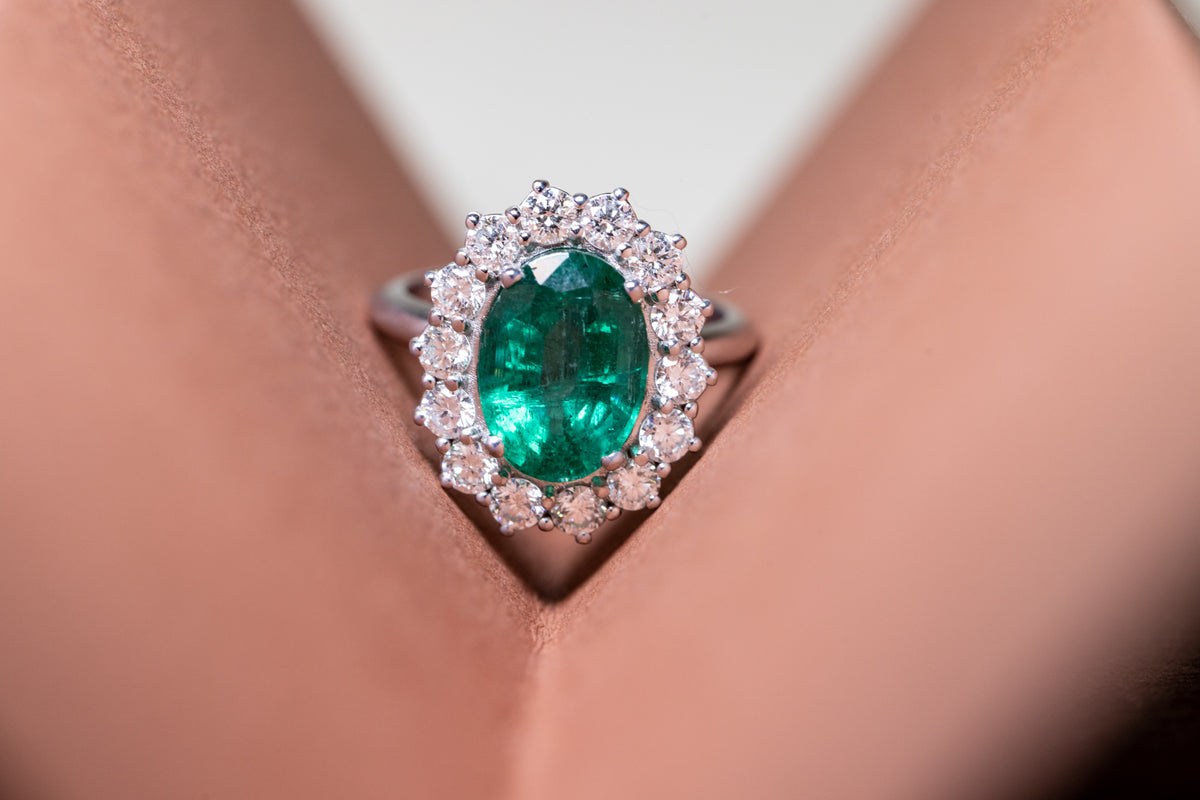A cutoff criterion is established when internal gas bubbles, embedded crystals, veils and cracks make the emerald too cloudy or milky.
It should also be added, however, that the presence of small spots and cracks inside these gems does not always have a negative value.
Sometimes the tiny shapes that can be glimpsed through the table (top part) of a cut gemstone form fascinating designs that enhance the uniqueness of a faceted crystal.
In the case of emeralds, they are indicated with the suggestive French term Jardin (garden in Italian).
They can resemble moss or tree foliage and can form incredible figures that enchant particular buyers and connoisseurs of precious stones.

The mineral deposits
The types of deposits and places of origin do not so much influence the type of treatment that the stones can receive, although there are notable differences from deposit to deposit, but they impact above all the value linked to the fame of a particular place.
Many are familiar with Colombian emeralds, which are more famous and more sought-after than those from Zambia, Brazil, or Afghanistan.
Knowing the type of rocks from which these mini green treasures are extracted and the geological processes that led to their formation can help understand many of the aspects related to these stones.
Some of the world's emerald deposits are found in areas of contact metamorphism.
Granitic magma can serve as a source of beryllium, and nearby schist (a medium- to coarse-grained metamorphic rock) or carbonaceous gneiss (one of the most common metamorphic rocks constituting the continental crust) can provide chromium or vanadium.
Emeralds usually form in schists or gneisses or at the edge of a nearby pegmatite (a vein-like rock belonging to the granite family).
Mafic (or mafic, rich in iron and magnesium) and ultramafic rocks (with silica content less than 45%) can also serve as sources of chromium or vanadium.
These types of lithic environments, in one combination or another, are found almost everywhere in the world; for this reason, emerald mines are present today on every continent.
In 2010, the major producing countries of these green gems were:
Colombia 29% (whose extraction significantly increased in the decade between 2000 and 2010, increasing by 78%), Brazil 27%, Zambia 20%, Russia 10%, Zimbabwe 7%, Madagascar, 3%; Pakistan 2% (which has nevertheless significantly increased its presence and visibility on the market in recent years) and Afghanistan 1% (in recent months, due to well-known political problems, not open to trade), Canada 0.5%, rest of the world > 0.5%.
Since around 2015, significant quantities of emerald, with exceptional color and clarity, have begun to be exported from Ethiopia.
New deposits are constantly being discovered, but not all of them can boast high quality stones.
The limiting factor in the formation of emeralds is geological conditions, which translate into the absence or presence of beryllium (48th most common mineral, where emeralds are formed, at 2.8 parts per million or PPM), chromium (22nd, 102 PPM) or vanadium (20th, 120 PPM), elements that are relatively rare in the band of rocks in the Earth's crust in which emeralds form.

Untreated emeralds
For time immemorial, precisely because of their refinement, emeralds have been subjected to processes that increase their transparency and, possibly, the brilliance and vividness of their color.
Some of these measures are traditional, generally well known and relatively tolerated by both experts and consumers.
One of the oldest methods of improvement is filling fractures with natural oils.
It is said that 95-99% of all emeralds on the market have been “hacked” in some way, but of course no one can say for sure as there is no database that includes all the stones sold.
It is evident, however, that only a minimal portion of these gems remains untouched.
These are typically very high quality stones and are equally high in price.
In practice, when you buy an emerald, you can be virtually certain that the stone has undergone some form of manipulation.
When a dealer invites you to buy, claiming that the gem on offer has not been altered in the slightest (except for cutting and polishing), his words should ring a small alarm bell.
Untreated emeralds for sale are very few and normally fetch premium prices, especially those from the famous Muzo mine, located about 100 km from (Santa Fè de) Bogotá, the capital of Colombia.
An untreated Colombian emerald (from any of the mines in this state) can be up to 50% more expensive than one that has undergone minor oiling and has the same apparent quality.
A stone with moderate enhancement can shave an additional 35% off the cost of one with less treatment; finally, a gem with significant alteration is generally avoided by gemstone connoisseurs, not so much for the cost, but for the risks inherent in the type of treatment.
As mentioned previously, over 90% of emeralds in today's market have fractures filled with oil or resin.
Therefore, in all cases, it is necessary to take the utmost care during cleaning; ultrasound or steam should never be used to care for these stones.
Vibrations can weaken already fractured stones, while hot steam can cause oil or unhardened resin to leach from the surface.
To discover the characteristics of this beautiful gem, you can make an appointment at our boutiques to show you our creations dedicated to our Natural Emeralds.





